|
It's Friday the 7th of July, a balmy winter's day in South Africa, and the sun shines down on the small settlement of Grahamstown in the Eastern Cape Province. Silhouetting the gothic spire of the town's cathedral, the light falls on a lively crowd gathered at an outdoor stage, where dancers in traditional Zulu dress keep time to the rhythm of drums. Two ballerinas stand watching, point shoes slung over their shoulders. Strains of township jazz drift out from an unseen venue. Every wall explodes with posters that beckon to theatre of all kinds – masterpieces by Athol Fugard, Malawian interpretations of Ibsen, fusions of African dance, controversial criticisms of Apartheid-era liberals, tragedies of AIDS in Africa, works of purest fantasy, and much more besides. Welcome to South Africa's National Arts Festival, a gathering of productions from all corners of the continent.
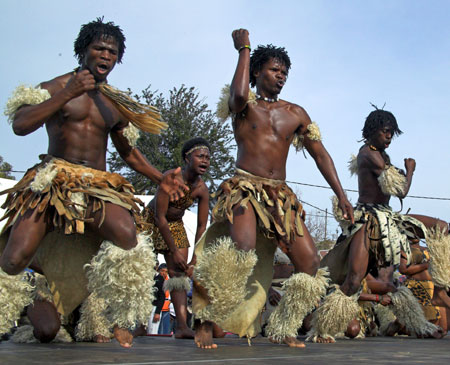 |
For much of the year Grahamstown lives a quiet, though not entirely sober, college-town existence. Thirty-six miles from the subtropical Indian Ocean coast, the town lies among grassy hills covered in aloe plants, watched over by the arid mesas of the KarooDesert a short distance to the west. It was founded in 1812 by British settlers from the CapeColony, and stood for many years as a frontier outpost along the FishRiver, before growing into the market-town it is today. The place abounds with architectural legacies of the colonial days – Cape Dutch houses line the streets behind rows of tall trees, while the market square brings together Gothic, Baroque, and Victorian styles of architecture. It's a beautiful place to visit at any time of year, rich in South African history and full of character.
It's perhaps appropriate that this old colonial outpost now plays host to Africa's largest and most diverse gathering of the arts. The National Arts Festival (more usually called the Grahamstown Festival) has been held in Grahamstown since 1974, and since then has grown dramatically in size and diversity. It's always been open to all, without censorship, and it became an avenue for protest and artistic expression through the years of Apartheid. In Grahamstown you could see performances by artists who were considered subversive by the lackeys of the Apartheid state, actors whose names were on lists of agitators compiled by the police, encoding messages within the metaphors of their plays and songs to escape the attention of the authorities. It would be a mistake to portray the Grahamstown Festival as a major part of South Africa's liberation struggle, which was fought on darker fronts in the townships of Soweto and Alexandria, but it did play a role in maintaining free artistic expression and healthy social commentary.
Today we live in a new South Africa. More than a decade has passed since Nelson Mandela was released from prison, and whilst the country is by no means perfect, the shadow of racial divide no longer looms as large. In the years since 1994, the festival has grown and changed dramatically. You'll now find many international acts alongside South African favourites, and a colourful fringe side has emerged. There are many parallels with the Edinburgh Festival, but at Grahamstown it is the African aspects that shine through strongly.
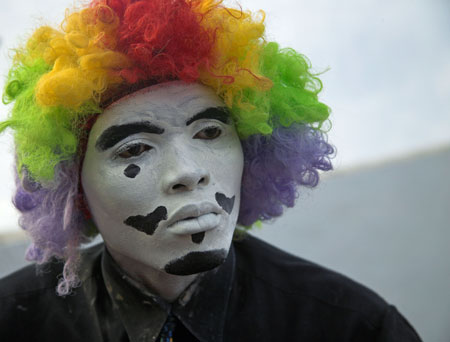
The festival is a strong indicator of the state of South African and African theatre, and the direction in which these arts are headed. Here one can get a sense of how local writers and performers are influenced by international ideas, which themes are occupying their attention, which hybrid styles of performance, music and dance are emerging from the riot of variety we enjoy in Africa.
So what actually happens at the festival? More than 600 productions descended on Grahamstown from 29 June to 8 July this year, playing at 80 venues across the town for approximately 2,300 performances. There's much to see, and ticket prices are so good it seems a shame to miss anything. However, as at Edinburgh, there's just not enough time enough to see it all, and popular events tend to book out quickly. To get there I drove the 700 mile journey down from Johannesburg, in the company of some actors who were taking a play to the festival. As we drove we debated which shows to see, calling the ticket office to make reservations while the dry winter vistas of South Africa's interior passed by outside. Plans came to a halt when we blew a gasket in the middle of nowhere, a serious engine failure which meant we had to stay overnight in an Afrikaner farming town. We spent the next day hanging around a mechanic's yard, growing frustrated at the thought of what we were missing, before finally commandeering some courtesy cars and making up for lost time on a night-drive across the KarooDesert. We arrived in Grahamstown at midnight, and I set out the next day with a fistful of tickets.
The Village Green is the heart of the Grahamstown Festival, filled with people at all hours of the day.
Open air stages showed performances that ranged from Xhosa warrior dances trough calypso steel-pan ensembles, to big band afro-jazz and acapella Zulu harmony. Here and there the crowd was punctuated by street performers, playing kwela music on violins made from oil-cans, or dressed as Whiteface clowns. From the Village Green the action spreads out into the many festival venues. There were grand multi-tiered theatres, there were small backrooms that had been pressed into service with the use of some wooden boards and a few rows of plastic lawn-chairs, there were outdoor stages on the grass. I started at the top, with the new production of Sizwe Banzi is Dead by Athol Fugard.
Fugard is perhaps our most prominent playwright, and his name has been on many lips since Tsotsi took an Oscar. Sizwe Banzi is Dead was first staged in 1972, when it garnered a Tony Award and took Fugard's recognition to new heights. This year saw the play return to South Africa with its two original actors – John Kani and Winston Ntshona, an irrepressible duo that have defined Fugard's theatre and delighted audiences for many years . Telling the story of a struggling township photographer during Apartheid, Sizwe Banzi held the 'new' South African audience transfixed. Ntshona and Kani were as good as ever – leavening the absurdist tragedy of the story with their acute sense of comic timing. It's refreshing to see this headline piece performed in our changed society – now that we have no pass laws and no legal divisions, our appreciation of this kind of theatre has changed. The audience was judging this more as a piece of art than a work of politics, though I doubt the two can ever be wholly separated. It was the most loving performance of Fugard I've seen – there were another two of his plays at the Grahamstown festival alone, including a premiere performance of his new play, Booitjie and the Oubaas.
The festival was thankfully not lacking in controversy. Catherine Henegan's multimedia production,The Shooting Gallery, divided audiences like no other – some walked out, some gave standing ovations, others sat in stunned silence long after the play had ended. Woven loosely around the story of the war journalists Kevin Carter and Ken Osterbroek, the play gouged at the unhappy divide between the grim reality of world events, and the media's profane hunger for these events as sensation-generators – 'if it bleeds, it leads'. The lead was acted by radical literary figure Aryan Kaganof, who spent much of his time suspended naked and upside-down before a huge screen, while images of the globe's violent conflicts were projected into him. He went on to smear himself with blood and crawl through the audience, leaping up to answer a call on his cellphone, from his mother. This was strong theatre, though too disjointed to fully realise its potential. But The Shooting Gallery was a worthy addition to the festival, and shame on the South African newspaper that slated it in their review, saying 'We South Africans just want to be entertained'.
From the radical to the traditional, from the imposing Rhodes Theatre to a small backroom of the market hall. Here Nakedi Ribane staged her low key review -Siyavaya – African Jazz Dance. A nostalgic tribute to the days of jive and jazz in the townships of Soweto and long-lost Sophiatown, the show enthused the audience so much that they practically stormed the stage on a few occasions.
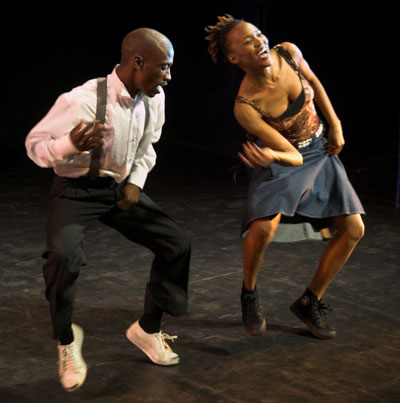
Charting the course of a day in township life, Ribane's dancers had me jiving in my seat, while they wove deft patterns across the floor to the sound of kwela (an energetic style of South African street music) and jazz melodies. A musical contrast was provided in Vanity Faire, by the Cape Academy of Dramatic Arts, though it was no less impressive in energy or spirit. Ballet fused rhythmically into modern styles, with sumptuous costuming and some unexpected singing from the dancers.
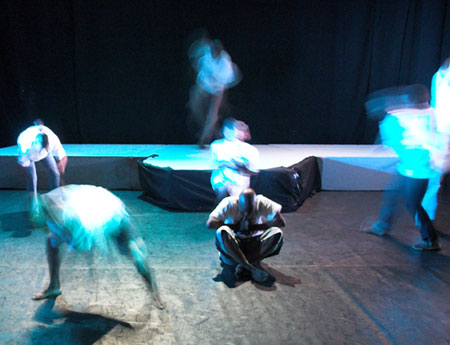
From dance I moved on to the small one-man shows that make up much of the fringe. Peter Krummeck returned to Grahamstown with his much-lauded play, Bonhoeffer. A masterpiece of character acting, Krummeck unfolded the softly-spoken life of Dietrich Bonhoeffer, the priest who was jailed for refusing to swear allegiance to Hitler. After sell-out performances in the U.S. and Europe, the play now returns to the States and Canada for another season.
In contrast to Bonhoeffer's realism, Electric Juju by Rob Van Vuuren took us on a journey through sheer fantasy – a traveller in an unknown desert discovers the heart of a giant, and must protect it from Juju, the dark figure who wants to eat the heart to gain its powers. Bringing together elements of Tolkien, Pratchett, and African mythology, van Vuuren's play was pure delight, refreshingly free from any ideological weight.
The list of good productions goes on – Breaking the Pot, a Malawian interpretation of The Doll House by Ibsen; iVirgin Boy, which set a young man's coming-of-age against the backdrop of Africa's AIDS struggle; Medumo Afrikan Ballet, a gathering of styles from the disparate corners of African dance. The experience of Grahamstown is heady and diverse, though not without a few disappointments. Some productions were pared down and lacking in impact – most companies had something to say about their funding. Funding for the arts is becoming increasingly scarce in South Africa – understandable in a country where almost half the population live below the poverty line. But there are problems in the way available funding is given – it seems that merit does not guarantee support. It is with much sorrow that we hear of the possible closure of the First Physical Theatre Company, one of South Africa's most talented groups, which has performed to great acclaim at Edinburgh and other venues.
That was the theatre, but by no means all of the festival. Between performances we'd sit back and listen to street musicians, eat boerewors and pap, or walk the hills overlooking town. The outskirts of Grahamstown fade away into expanses of veld, the aloe plants flower in flaming red lances, birds call from the grassland. At the end of the day we'd find our way to one of the many live music venues across town, where luminaries of African music played out the night. Steve Newman, virtuoso guitarist from 1980's African group Tananas, held court in a smokey underground bar, where he played Latin-African melodies on a guitar which has been built to incorporate a traditional thumb-piano. Zimbabwe's Louis Mhlanga had us dancing joyously to his Mbira style. The anti-Apartheid author Riaan Malan sang an evening of husky Afrikaans boeremusiek. The African roots of jazz were explored in ecstatic sessions by the bass of Concord Nkabinde – find a copy of his Bluegrass Kwela for some innovative sounds. On the final night we sat in awe of Jimmy Dludlu's guitar – a man who has played with the best, setting us on fire with his resonant Afro-Jazz.
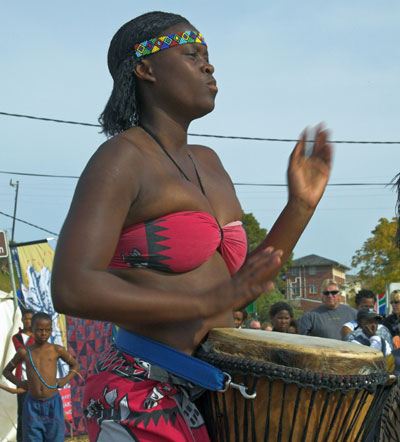
It's easy to compare Grahamstown to major festivals like Edinburgh or Adelaide, but the attraction of Grahamstown lies in its differences. The large international festivals may have the greatest variety of productions, a bewildering array of venues, copious sponsorship, and their own unique atmospheres. I'll miss being amongst the madness of Edinburgh this year. But the Grahamstown Festival more than makes up for its smaller scale. Here you'll see accomplished acts of world-class theatre contrasted with low-budget productions full of African character. Many of these plays will never make it overseas, as there simply isn't the funding. They represent the changing face of theatre and music in this challenging part of the world, where these art forms are in some sense luxuries whose existence must be justified in the face of harsher reality. At Grahamstown I heard music that sadly won't be recorded or played on any World Music station. I ate local food while walking the old colonial streets of the town, where Xhosa children lie in hammocks between the trees. The setting of Grahamstown is unrivalled – take a half-day out from the events, a short drive, and you'll be swimming in the Indian Ocean. A half-hour in the other direction and the scrub desert waits silently. This is a proudly African festival, with a cosmopolitan edge. If you're interested in what's happening with the arts of the Dark Continent, particularly Southern Africa, I'd recommend a visit. I saw some great shows, and missed much more. After eight full days I drove back to Johannesburg in the company of my acted-out actor friends, wondering how I'll get from Grahamstown to Edinburgh this time next year.
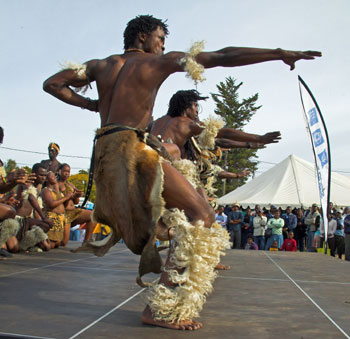
|